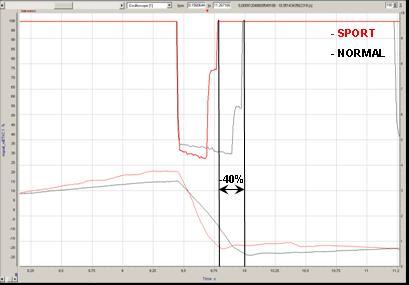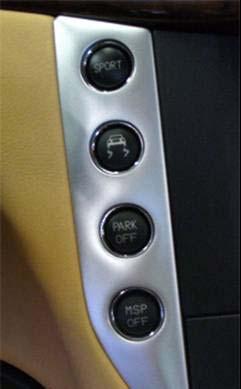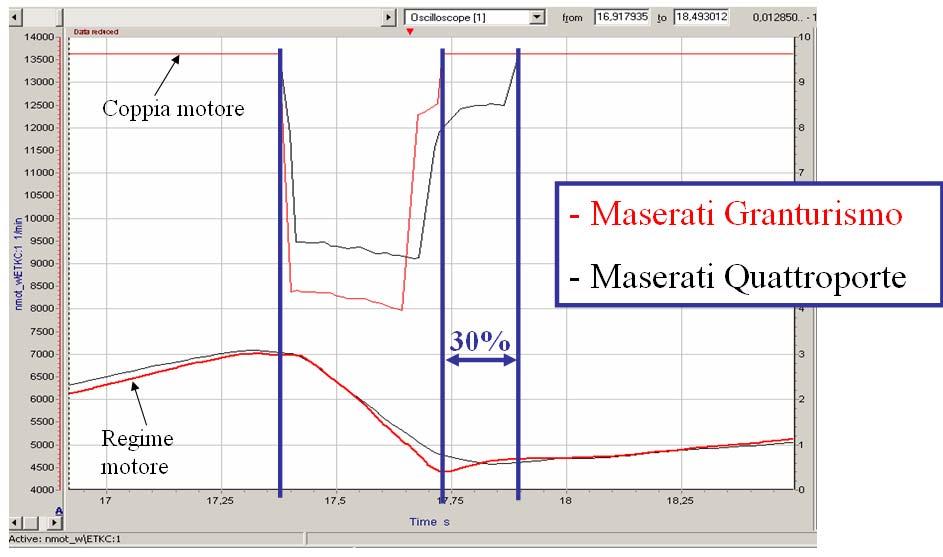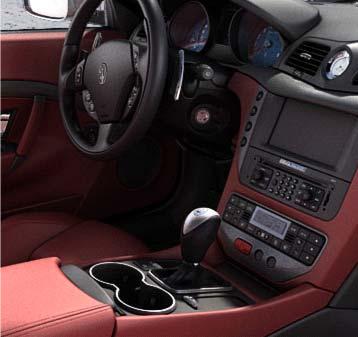
8 minute read
IntroductiontoMaserati
3. Transmission
Maserati GranTurismo
The automatic transmission of the Maserati GranTurismohas been engineered to offer the best possible compromise between performance, driving comfort and fuel economy. It consists of the following components:
ZF 6HP26 automatic 6-speed gearbox: hydraulic gearbox with torque converter, lock-up clutch and integrated control unit (Mechatronic). Various driving modes are offered: fully automatic gearchangein normal, sport or ice mode, or manual sequential gear selection by use of the gearshift lever or gearshift paddles at the steering wheel. This gearbox is mechanically identical to the one used in the QuattroporteAutomatic. The controlling software is specific for the Maserati GranTurismoto enhance the sporty character of the vehicle (faster gearshifting).
Composed transmission shaft: the transmission shaft is composed of a front and rear part and uses three homokineticjoints. This solution was chosen because of a slight desaxationbetween the gearbox output shaft and the differential input shaft, both in the horizontal and in the vertical surface. The transmission shaft is sorter as the one used in the QuattroporteAutomatic due to the sorter wheelbase. Note: the transmission shaft requires a balancing procedure after the removal of transmission components (gearbox, transmission shaft, differential). This balancing procedure is identical for GranTurismoand QuattroporteAutomatic.
Grazianolimited slip differential: with respect to the differential of the Quattroporte Automatic, the final drive ratio has been changed. This was doneto improve performances and reduce differential noise.
Note: see chapter 3 “Mechanical Components”for more detailed information on the individual transmission components.

Maserati GranTurismo
Adaptive gearbox strategy
By enhancing and synchronising the transmission control with other systems in the vehicle (e.g. engine, braking system, driving wheels and steering wheel)a series of signals are made available: these provide a description of the driving condition in real-time. After applying longitudinal or lateral acceleration, the ECU activates(through acquisition of signals such as engine speed and torque, oil temperature, accelerator position and movement and the rotating speed of the individual wheels) implementation of additional functions of the electronic transmission control. Based on this information, the transmission control is capable of recognising whether the vehicle is in a curve and whether the driver is braking or wishes to accelerate. By means of these signals, it is possible to draw conclusions relating to the actual vehicle loadand the topography of the road (uphill or downhill) which can then be applied to the transmission function. This system is known as automatic transmission with adaptive transmission control. It is capable of recognising the driver’s intentions, recording the driving style and consequently adapting the gear selection. Manual operation is therefore not necessary. ZF GetriebeGmbH and Robert Bosch GmbH have worked together with Maserati to produce new software for the electronic transmission control, which contains some very useful functions. The Adaptive Shift Strategy (ASIS) is based ona few important factors. Gear selection depends on the gradient of the slope while driving. The novelty is represented by the capability of continuously adapting the gearshifts to the individual driving styles which may vary infinitely from racing-style (dynamic) to extremely “economic”driving.
All the functions and their operating modes are described and represented in this brief description of ASIS. Examples of signals sent by other systems in the vehicle are given together with the evaluation these systems provide for electronic transmission control.
Lateral acceleration: The transmission ‘learns’the driver’s style and assigns a theoretical count system to certain driving scenarios. When it recognises anacceleration action, including after long periods of regular driving, it increases the number of counts for the driver until reaching the maximum level in approximately 10 seconds. The resulting counts for the driver and the time it takes to reach this level dependson the lateral acceleration level.
Longitudinal acceleration: The longitudinal acceleration is evaluated mainly to allow a decrease in counts when the driving style is constant and no other information is available (pick-up or lateral acceleration). When the driver brakes, the count system is stopped.
Calculation of the road gradient: The road gradient is calculated by comparing the actual acceleration of the vehicle with the acceleration the vehicle would have when driving on a thoroughly level road. Acceleration on a level road is calculated based on the vehicle weight and the actual torque delivered by the transmission. The ASIS system distinguishes 5 different categories of road gradient, each of which is associated with a gearshift map. The five conditions are: downhill, level, and three different uphill gradients.
Auto Normal mode
Normal driving style and reduced consumption. In the case of a driving style watchful of consumption and with reduced acceleration levels (longitudinal and lateral) the gearshift programmes are adjusted in such a way as to obtain maximum cruising comfort. In order to reduce vibrations and acoustic feedback of the engine to a minimum, upshiftingmust be performed as quickly as possible. Downshifting during pedal release or downhill driving (0% pedal depression) occur at 1000 RPM. Downshifting following the action on the accelerator and/or brake pedal is less aggressive than inthe other modes.
Racing-style driving:
When a more racing-style driving is detected in Auto Normal mode, upshiftingwith reduced pressure on the pedal occurs at a higher engine speed. In this way, the gearbox and engine have a greater reserve of power without having to downshift. Anticipation of downshifting during braking considerably increases, so that the correct gear is engaged before entering a curve.
Auto Sport Mode
Generally, when using Sport mode, gearshiftingoccurs at much higher RPM and, at the same time, as a result of the fuel cut-off, gearshiftingis faster than in Normal mode with a reduction of up to 40% in gearshift times. This difference is very evident when the accelerator pedal is not fully depressed (i.e. pedal at 40%). The fuel cut-off technique designed for the Maserati GranTurismo(see the image that illustrates gear engagement from second to third gear at 7000RPM with accelerator pedal depressed by 40%) permits reducing the time necessary to cut the torque to the engine, shift gears and provide power once again. Normal drivingstyle and reduced consumption.

IntroductiontoMaserati
When using Sport mode in normal driving conditions without high lateral acceleration, the gearbox management software as a rule uses a lower gear than would be used in similar conditions in Auto Normal mode. Without operating the accelerator/brake pedal, downshifting is requested at about 1500 RPM. This makes the gearbox response much more racing-like without significantly affecting driving comfort. When driving on a motorway, 6th gear is engaged at a speed of 125 km/h. Racing-style driving:
In order to achieve the best reactivity, the gearshift maps are set to very high engine speeds. With reduced pressure on the pedal or with the pedal at 0%, upshiftingoccurs at approximately 4000 RPM. Downshifting, following an action on thebrake pedal, is adjusted in such a way that the gear is engaged before going into a curve, so that the driver has optimal control and an adequate reserve of power to come out of the curve. This mode is therefore specifically designed for driving at high speeds or for very difficult road conditions.

The automatic electronically-controlled gearbox has 6 forward gears and one reverse gear. In addition to automatic gear selection, the gears can also be selected manually.
The lever position is shown on the gear display by the illumination of the corresponding letter. This letter is also shown on the instrument panel display. The engine can only be started when the gearshift lever is in P or N.
WARNING: After starting the engine and setting off, do not depress the accelerator pedal before and while shifting the gearshift lever. This is particularly important when the engine is cold.
Shift-Lock
This safety system allows you to shift from P (PARK) to another position only if the brake pedal is depressed. This prevents the vehicle from involuntarily jumping forward or backward.
Key-Lock
After turning off the engine with the gearshift lever in a position different from “P”, the key can be extracted within a maximum time of 30 seconds. When this time has elapsed, the key can no longer be removed from the ignition block. To remove the key, you must turn it to ON and then back to OFF.
WARNING: In the case of an emergency, (e.g., breakdowns, dead battery etc.) the ignition key can be removed even if the gearshift lever is not in P. To do this, turn the key to STOP, press the button A on the gearshift lever and at the same time remove the key.

CAUTION!
When parking on steep slopes, it is recommended to shift the lever to PARK before leaving the vehicle (whether the engine is running or not). This is recommended since the EPB system installed in the vehicle is capable of ensuring that the vehicle is properly parked and stationary when fully laden only on a gradient up to 20%
Selecting automatic or sequential manual operating mode: The gearbox can be used both in fully automatic (position D) andin sequential manual (positions + or -) mode.
The operating modes can be activated through the following selections:
•D automatic gearshifting(AUTO)
•M (+ / -) Sequential manual gearshifting(MANUAL)
The lever can always be shifted between these two positions evenif the vehicle is moving and without depressing the brake pedal. The lever can continuously be shifted between D and M.
If automatic gearshift mode is selected, the word AUTO and the letter D will be shown on the instrument panel display, while for sequential manual gearshifting, the word MANUAL and the gear engaged will be shown.
Automatic selection operating mode
Select the D (drive) position when you wish to use all the automatic gearshift functions. With the vehicle stationary and the brake pedal depressed, shiftthe gearshift lever to D; if the gearshift lever is in P or R, also press the button A on thelever knob. When the function is set, the letter D illuminates on the gear display and on the instrument panel. With this function active, the ECU controls automatic engagementof the six gears. The gears will be engaged in relation to the travelling speed, engine RPM, accelerator position, speed with which the pedal is depressed, as well as the travelling conditions (uphill, downhill, curves).
The system is programmed to classify all driving styles related to the above mentioned parameters, matching them to ten different vehicle settings which go from extremely comfortable and fuel-economy driving to full racing-style driving. The setting is selected automatically.
Kick-down strategy
This strategy is activated by rapidly and fully depressing the accelerator pedal, which causes engagement of a lower gear than the current one; this function assists the driver when maximum acceleration is required. When the pedal is released, the best gear in relation to the vehicle speed and the position of the accelerator pedal is automatically engaged. The kick-down strategy can be activated only when automatic operation has been set, with the gearshift lever in position D.
Manual selection operating mode
Push the gearschiftlever to the left from the D position to select the manual mode. To engage the gears, move the gearshift lever to the following two positions:
+ UP to engage a higher gear
- DOWN to engage a lower gear.
The Maserati GranTurismohas gearshift paddles behind the steering wheel as a standard feature. In sequential manual operating mode, upshiftingand downshifting can be controlled not only with the gearshift lever but also with the two levers positioned behind the steering wheel. Also in automatic gearbox operation with the gearshift lever positioned in D (drive), you can request a gear different from the current one by activating one of the levers. This action will temporarily switch the system to sequential manual operation. If you then keep to a constant driving style (low longitudinal and lateral acceleration), the gearbox automatically switches back to automatic operation.
WARNING: Even if manual gearshiftingmode has been activated, some functions are still controlled automatically. When the engine is overrevvingor underrevving, the system automatically engages a higher or lower gear.
WARNING: If you request a gearshift in conditions where the engine is overrevvingor underrevving, the system will not accept the command.
WARNING: The electronic control unit is programmed to handle one gearshift at a time, therefore, fast and repeated requests will not necessarily result in a gearshift. The higher or lower gear is engaged only if the previous gearshift procedure has been completed.










